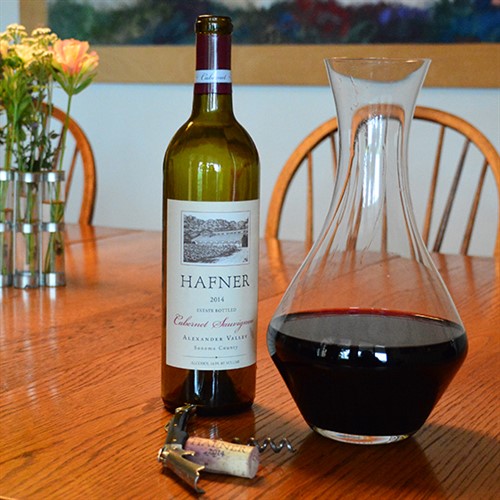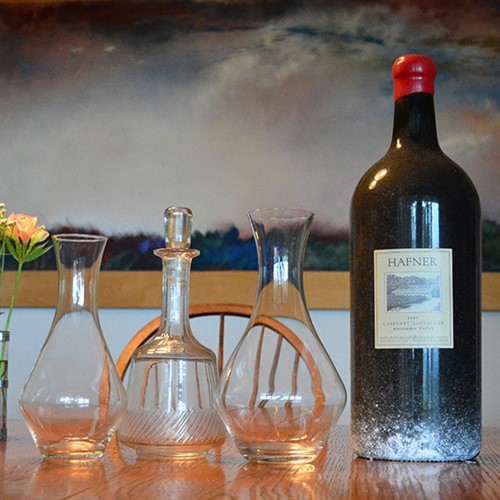Decanting Wine
- July 21, 2020
Everyone’s tastes are different. Some people enjoy their wines cold right out of the frig, others prefer them cool and still others like them at room temperature. There is no right or wrong answer; it is just like ordering a steak; it’s an individual choice. If and when to decant is similar in many ways, but there is some science that influences why and when you should decant.
Decanting (pouring the wine from the bottle into another vessel, typically a decanter) is a simple, but careful process. You don’t just tip the bottle over and let it splash into the decanter; you allow the wine to flow slowly down the side of the decanter. Sommeliers may use a candle to increase the theatrics of the evening, but this is not necessary as you will soon learn. There are three reasons to decant a wine. The first one is probably the most common: to remove the sediment of an older wine, so that when you pour a glass from the decanter, you don’t get any sediment in the glass. However, if you decant an older wine, you risk accelerating the aging of the wine.
There are three reasons to decant a wine. The first one is probably the most common: to remove the sediment of an older wine, so that when you pour a glass from the decanter, you don’t get any sediment in the glass. However, if you decant an older wine, you risk accelerating the aging of the wine.
When you decant a wine, you aerate it; in other words, you add oxygen to it. Older wines tend to be more fragile; their aromas are delicate, so aerating an older wine is the exact opposite process you want to do. Essentially, you are adding more age to the wine and those delicate aromas vanish. When we want to enjoy an older wine at home, we don’t decant it; we just pour it slowly, so we don’t disturb the sentiment at the bottom of the bottle. To ensure that the sediment is at the bottom, we bring the wine up from the cellar several hours before we plan to enjoy it and stand it up right.
The second (and in my mind the real) reason to decant a wine is to accelerate the aging. We have learned this technique over the years from our French interns. (Our interns live with us for 3-4 months while they are studying winemaking. A few years later when they return to California as professional winemakers, they bring their latest wines for us to critique and enjoy.) Before we open the wines, they always insist upon using a decanter to allow the wines to be more developed and interesting. Here’s a quick way to decide if you should decant a wine: open the bottle, pour just a little bit and taste it. Then swirl the wine in the glass around several times (you are simulating decanting it by aerating it) and taste it. If you prefer the “swirled” wine, then decant the bottle. If you prefer the first taste, then don’t decant the wine.
Here’s a quick way to decide if you should decant a wine: open the bottle, pour just a little bit and taste it. Then swirl the wine in the glass around several times (you are simulating decanting it by aerating it) and taste it. If you prefer the “swirled” wine, then decant the bottle. If you prefer the first taste, then don’t decant the wine. The third reason to decant is a practical one. There is nothing more fun than to have a double Magnum or a Jerobaum on your dining room table. Large format bottles are perfect to celebrate with family and friends. However, pouring wine from a Jerobaum can be challenging at best. Over the years, we have bottled a few large format bottles and enjoyed them on special occasions. In order to serve everyone easily over the course of the evening, we carefully decant the wines into several decanters and then use them to fill everyone’s glasses.
The third reason to decant is a practical one. There is nothing more fun than to have a double Magnum or a Jerobaum on your dining room table. Large format bottles are perfect to celebrate with family and friends. However, pouring wine from a Jerobaum can be challenging at best. Over the years, we have bottled a few large format bottles and enjoyed them on special occasions. In order to serve everyone easily over the course of the evening, we carefully decant the wines into several decanters and then use them to fill everyone’s glasses. There are practical reasons to decant a wine, but whether you decide to decant or not is a personal one. You can have fun in that decision-making process by testing to see if the wine improves with decanting or not. Enjoy and as they say in Italy “cin cin”!
There are practical reasons to decant a wine, but whether you decide to decant or not is a personal one. You can have fun in that decision-making process by testing to see if the wine improves with decanting or not. Enjoy and as they say in Italy “cin cin”!



